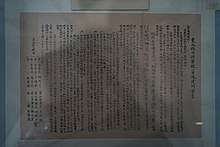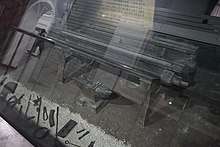Northeast Anti-Japanese United Army
The Northeast Anti-Japanese United Army was the main anti-Japanese guerrilla army in Northeast China (Manchuria) after the Japanese invasion of Manchuria in 1931. Its predecessors were various anti-Japanese volunteer armies organized by locals and the Manchuria branches of the Communist Party of China (CPC). In February 1936, the CPC, in accordance with the instructions of the Communist International, issued The Declaration of the Unified Organization of Northeast Anti-Japanese United Army and marked the official formation of the organization.[1]
| The Northeast Anti-Japanese United Army | |
|---|---|
| Active | 1936–1945 |
| Country | |
| Allegiance | Communist International |
| Type | Army Light Infantry |
| Role | Guerrilla Warfare |
| Engagements | Second Sino-Japanese War, Soviet invasion of Manchuria |
| Commanders | |
| Notable commanders | Yang Jingyu, Li Zhaolin, Zhou Baozhong, Zhao Shangzhi |
| Northeast Anti-Japanese United Army | |||||||||
|---|---|---|---|---|---|---|---|---|---|
| Chinese name | |||||||||
| Traditional Chinese | 東北抗日聯軍 | ||||||||
| Simplified Chinese | 东北抗日联军 | ||||||||
| |||||||||
| Korean name | |||||||||
| Hangul | 동북항일연군 동북항일련군 | ||||||||
| Hanja | 東北항일연군 東北항일련군 | ||||||||
| |||||||||
Formation
Predecessors
After the Mukden Incident of 1931, the people of Liaoning, Jilin and Heilongjiang provinces begun to organize guerrilla forces to join Anti-Japanese Volunteer Armies and carry out guerrilla warfare against the Kwantung Army and the forces of Manchukuo. The Chinese Communist Party also sent cadres to join the local military struggle. Yang Jingyu joined the guerrilla force in Panshi. Zhou Baozhong united with Wang Detai's force in Yanji. Li Zhaolin was sent from Liaoyang to the county committee of Zhuhe to form local guerrilla force. Zhao Shangzhi joined the guerrilla force in Bayan. Choe Yong-gon went to east Jilin to develop party organizations and form guerrillas. Feng Zhongyun was sent to Tangyuan as the representative and inspector of the Manchuria provincial party committee to form guerrillas.[2][3]
Contradictions and the Low Ebb
The "Northern Conference"
In June 1932, the Chinese Communist Party convened the "Northern Conference" (the northern provincial committee secretaries meeting) in Shanghai, criticized the "particularity" of Manchuria proposed by the Manchuria provincial party committee, and decided that the Northeast should focus on the agrarian revolution to seize land from the landlords, form Red armies and establish Soviet government. As a result, guerrilla forces leading by communists were ordered by the Manchuria provincial party committee to be rearranged as Red armies and fight independently.[4]
The "Letter of January 26"
In early 1933, CPC central committee was moved from Shanghai to Jiangxi Soviet. At this period, the Manchuria provincial committee was led by both CPC's delegation to the Comintern and the branch of central committee in Shanghai.[5]
In January 1933, CPC's delegation to the Comintern issued "the Letter of January 26" under the name of the central committee. The letter called to correct the "leftist problem" caused by the Northern Conference. It proposed to establish an anti-Japanese united front instead of focusing on agrarian revolution. The Red armies were renamed as Northeast People's Revolutionary Army and were urged to cooperate with other anti-Japanese forces to establish the anti-Japanese united front.[4]
The "Letter of February 22"
In February 1934, the temporary Politburo of the CCP in Shanghai criticized the Manchuria provincial committee in the "Letter of February 22" for its "rightist mistake" to misinterpret the Letter of January 26. The letter pointed out the danger of "leader's collusion instead of people's united front" and requested to put forward the slogan to go to the stage of agrarian revolution. At the same time, CPC's delegation to the Comintern also took a series of measures in its organization to try to eliminate the influence of Letter of February 22. Cadres were sent back from the USSR to Manchuria to make clear instructions and future tasks of the united front.[5]
The Official Formation of the NAJUA

From March 1934 to February 1935, the temporary Politburo of the CCP in Shanghai was severely damaged in several anti-communist campaign and stopped its activities in July. And at the time, the CPC central committee was in its Long March. As a result, from the first half of 1935, the Manchuria party organizations were actually under the independent leadership of the delegation to the Comintern.
In June 1935, CPC's delegation to Comintern issued the "letter of June 3" to the party organization in Manchuria. The letter called for a new policy, that was, the implementation of the all-out anti-Japanese united front, regardless of party, class or ethnic. This letter was consistent with the Popular Front against fascism proposed in the Seventh World Congress of the Comintern and the far-reaching anti-Japanese united front promoted in the "August 1 Declaration" of CPC.[1]
In February 1936, communist leaders including Yang Jingyu, Li Zhaolin, Zhou Baozhong, Zhao Shangzhi, and Wang Detai jointly issued the Declaration of the Unified Organization of Northeast Anti-Japanese United Army. Northeast People's Revolutionary Army was reorganized as the Northeast Anti-Japanese United Army.The Northeast Anti-Japanese United Army was in a stage of development from 1936 to 1937.[5]
Affiliation
Officially, this army was led by the Chinese Communist Party. In reality, they did not directly report to the CPC center in Yan'an due to geographical separation. Their only contacts with the CPC in Yan'an were through the CPC representatives in the Communist International, Kang Sheng and Wang Ming.
They were supported and instructed by the USSR, which supported this army to tie up the forces of its potential Japanese enemy. Their uniforms were copies of the uniform of the Soviet Red Army.

Components
The army was a mixture of various sources, with the same objective – expelling Japanese out of Manchuria. They were communists, students and peasants, former troops of the warlord Zhang Xueliang, and even bandits. The former bandits played an important role in the guerrilla war by using their skills in the mountains. Most of the high and middle rank officers had Communist Party membership, including former bandit leaders.
Koreans in the Northeast Anti-Japanese United Army
The army contained a large number of ethnic Koreans, both the Koreans from Manchuria, and Koreans from the Korean Peninsula. By 1918, there were virtually no organized armed revolts against Japanese colonisation on the Korean Peninsula and many Koreans chose Manchuria as a place to resist Japanese Imperialism. Two of the legendary "Eight Girls Jumping Into the River" were Korean Chinese. This was a squad of girl guerrillas, aged from 13 to 23; after a long firefight with overwhelming Japanese forces who mistook them for a much larger unit, they all jumped into the river, drowning themselves to avoid capture and torture.
Kim Il-sung, later to become leader of North Korea, was a high-rank officer in this army, and attained a distinction that he cross the Manchurian-Korean border and attacked Japanese police station in Pochonbo at 1937. It was widely reported by Korean presses such as Donga Ilbo and he became famous in Korea as the most prominent leader of the anti-Japanese movement. After the war, some of the Korean nationals in this army became the first generation of the leaders of North Korea. Besides Kim Il-sung, An Gil, Kim Chaek, Choe Yong-gon and Kang Kon were also Korean high-rank officers of NAJUA, later assumed high positions in North Korea.[6]
Retreat to USSR
At the peak of their activities, NAJUA had a force of 10,000 troops. They launched the guerrilla warfare in the rear of Imperial Japanese Army, who was invading the main land China. IJA officers and the Imperial General Staff realized that NAJUA was the main threat to their operations mainland China. So it was the IJA together with Manchukuo army began the operations to sweep NAJUA in mid-1930. Like NAJUA, Manchkuo army included many Korean officers who pledged their loyalty to Japan. Such Korean officers were Park Chung-Hee, Paik Sun-yup, and Chung Il-kwon, who later became the full generals in South Korean Army and (after May 16 coup) high rank officials in South Korean government. It also had a special troop, Gando Special Force (Chinese: 間島特設隊, Korean: 간도특설대), which consisted mainly of Koreans. They assumed the most difficult tasks to attack the rising army.
As the offensive of Japanese army got fierce, NAJUA suffered heavy casualties. Many of their soldiers were dead or taken prisoner. Moreover, Japanese military intelligence allured or tortured NAJUA prisoners to convert to Japanese side. The converted one assisted Japanese to attack their ex-comrades. In his autobiography, With the Century (세기와 더불어), Kim Il-Sung recalled that such conversions of ex-comrades were more painful than Japanese fierce offensive or tough climate in Manchuria. By these reasons, NAJUA could not make activities in Manchuria any more. By the order of CPC, NAJUA escaped to the USSR. There, they were formally incorporated to the Red Army, as the 88th International Brigade, but they kept the organization of NAJUA. The troops remaining in Manchuria were totally annihilated by Japanese. The escaped troops stayed in USSR until the war ended. After Japan surrendered, Koreans and Chinese went back to their own countries and began the revolutionary activities there.
Contemporary attitudes in the PRC and ROC
The Northeast Anti-Japanese United Army remains highly regarded in mainland China. In mainland China, this army is generally viewed as a CPC-led anti-Japanese outfit.
A Chinese Communist leader, Peng Zhen, compared the extreme hardship suffered by the army with the Long March.
Besides legendary commanders Yang Jingyu and Zhao Shangzhi, a female officer called Zhao Yiman (1905–1936) was also revered by many Chinese as a symbol of the national salvation.
See also
- Anti-Japanese volunteer armies
- Chinese Red Army
- Chinese Soviet Republic
- Communist International
- Eighth Route Army
- Japanese imperialism
- Korean independence movement
- New Fourth Army
References
- 东北抗联:绝地战歌. 中共党史出版社. 2012. ISBN 9787509815670.
- 东北抗日联军史. 解放军出版社. 2014. ISBN 7506567180.
- 东北抗日联军抗战纪实. 人民出版社. 2005. ISBN 9787010050393.
- Coogan, Anthony (1994). "Northeast China and the Origins of the Anti-Japanese United Front". Modern China. 3: 283–314 – via Jstor.
- "中共驻共产国际代表团与中国抗日战争——以抗日民族统一战线的形成和发展为线索". 中共党史研究. 5: 16–24. 2005.
- Patrick Fuliang Shan, "Hero, Heroism, and Hero-worship: An Analysis of the Chinese Collective Memory of Yang Jingyu," American Review of China Studies (vol. 18, no. 2, Fall 2017), pp. 43-65.
External links
